2018 President’s Report
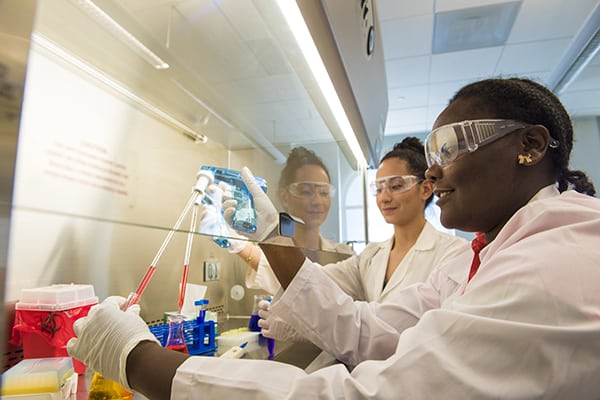
Kimberly Cruz and Raissa Audrey Tseumie perform research in a lab in the new Payden Academic Center.
“Research turned out to be one of the best things I did in my undergraduate career. In the summer after my sophomore year I did research on multiple sclerosis in the neuroscience lab at Children’s National Medical Center and that opened a lot of opportunities for me; as a result, I went to Stanford in the summer after my junior year where I conducted addiction research in a neuroscience lab…” – Kimberly Cruz, Biochemistry major, Class of 2018
On a glorious April afternoon, it was standing room only as students and faculty packed into the Payden Center to present this year’s undergraduate research projects and hear from some of the best student researchers like Kimberly Cruz whose experience last summer at Stanford was just one of many prestigious research opportunities on display during Spring Research Day.
The brainchild of Clare Boothe Luce Professor of Biochemistry Dr. Patrice Moss, Spring Research Day has become an important “new tradition” at Trinity, showcasing student research projects from many disciplines including Biology, Biochemistry, Chemistry, Forensic Science, Environmental Science, Business, Communication, Psychology, and, yes, English!
Research projects presented during the 2018 Spring Research Day were as diverse as a Business major’s analysis of the Hershey Corporation, Communication majors’ analyses of gender and race in primetime television, an English major’s analysis of gender tropes in young adult literature, and a Biochemistry major’s analysis of volatile compounds in the air inside a car.
Undergraduate student research has always been an important part of Trinity’s pedagogy. Across the decades Trinity students have written extensive research papers and presented findings in class. More recently, the poster presentation methodology of academic science has also taken root in other disciplines as students and faculty have recognized the importance of public presentation and peer-to-peer engagement with the results of research. In recent years, with more grant support and faculty participation in the Council for Undergraduate Research, Trinity’s faculty across all disciplines and degree levels have expanded considerably the use of research as an engaging pedagogy for student success.
On the student panel during Spring Research Day, each student spoke of the importance of engaging research seriously as a gateway to advancing in their chosen professional fields. In many cases, research projects lead to internships that introduce students to professional work in their major fields, and the internships open up networks for ongoing academic and professional development.
Undergraduate research internships also help students to build self-confidence and overcome obstacles they know they will face in their professional careers. During the panel presentation, Ms. Cruz spoke of the challenge she felt as a Latina woman in the Stanford neuroscience lab, especially upon learning that one of the leading researchers was nominated for a Nobel Prize. But, she said, “When you show them that you are capable of understanding and synthesizing the information and producing work better than what they can produce, doing work that launches other projects in their labs, they start to value you and you start to become an important member of that scientific society.” Read Ms. Cruz’s Research Abstract and other research presentations.
With Dr. Moss’s leadership, Trinity science majors have developed proficiency in presenting the results of their research projects at major academic convenings. For the last three years, Dr. Moss has led a team of Trinity student scientists to the Annual Biomedical Research Conference for Minority Students (ABRCMS) where Trinity students have presented their research. At the November 2017 conference in Phoenix, Laura Garcia ’18, Biochemistry major, won an award for best poster presentation in the Social and Behavioral Sciences and Public Health discipline. This past summer she worked at Georgetown University on a project titled, “Retrospective Analysis of Barrett’s Esophagus: The Role Body Mass Index Plays in Successfully Treating BE and in the Recurrence of Dysplastic BE”.
Trinity students also won awards at the October 2017 University of Maryland, Baltimore County (UMBC) Research Symposium in the Chemical and Biological Sciences. Danielle Vado ’19 won first prize in the Chemical Sciences for her research on exposing the possible hazards of plug-in air fresheners. Marcella Gutierrez ’20 won second prize in the Biological Sciences for her research on the Hypertonia Machine.
Recent graduates of Trinity’s science programs have used the networks forged during their summer undergraduate research internships to evaluate graduate school opportunities or to make connections leading to excellent professional positions. For example, Charlene Valdez ’17, a Luce Scholar in Biology during her student days at Trinity, won an Amgen Fellowship to study at MIT in the summer between her junior and senior year, and now she is in the master’s program in Biology at New York University. Naya Eady ’16, also a Luce Scholar and Biology major, had summer research internships at the University of Georgia and Virginia Tech and she now is in the doctoral program at Cornell. These are just two of an amazing group of successful recent science graduates who reaped considerable benefits from the undergraduate research program.
Howard Hughes Medical Institute Grant
The success of Trinity’s undergraduate research program in the sciences led to a successful proposal to the Howard Hughes Medical Institute (HHMI). Empowering young women of color, especially those from historically marginalized backgrounds, to enroll and persist as science majors is exactly the purpose of the $1 million HHMI Inclusive Excellence grant that Trinity received starting in 2017. Working across the next five years, Trinity’s faculty in the sciences are developing new curricula and pedagogy to be able to engage even more students in the sciences. Undergraduate research internships are a cornerstone of the project, along with extensive mentoring and a robust program of faculty development to improve science pedagogy.
Dr. Cynthia DeBoy, Associate Professor of Biology, is the project director for the HHMI grant. As she wrote in the successful HHMI proposal, “Trinity’s proposal for inclusive excellence aims to provide long-term benefits to women of color, women from low-income areas and first generation students. We intend to demonstrate these benefits at Trinity, and with the support of the HHMI grant share our programs and practices nationally. Trinity’s enrollment is the enrollment of the future, and Trinity is the ideal environment for identifying best practices for inclusive, culturally competent programs for learning, achievement and career preparation in science.”
Dr. Cynthia DeBoy with students selected for summer research funded by a grant from NASA (left to right): Jade Bowman, Cierra Wiggins and Samantha Lazo-Contreras.
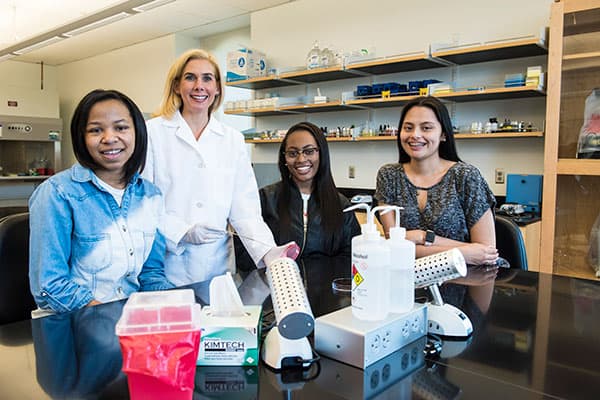
Dr. Cynthia DeBoy with students selected for summer research funded by a grant from NASA (left to right): Jade Bowman, Cierra Wiggins and Samantha Lazo-Contreras.
Other grants also have helped to support the development of undergraduate research at Trinity. Through the collaborative work of Dr. Shizuka Hsieh, Associate Professor of Chemistry, Trinity is a partner with American University on a NASA grant that supports faculty development and student research experiences related to NASA priorities. In summer 2017, six students conducted research at major university laboratories in the Washington region as part of their work on the NASA grant.
Trinity’s renaissance in the sciences and development of the science undergraduate research program would not have been possible without the development of the new laboratories in the Payden Academic Center and the acquisition of new instrumentation through significant grants. One major grant source is through the U.S. Department of Education program for predominantly black institutions (PBI); this grant is providing $2.4 million in support for equipment and faculty development in the science and nursing laboratories. As an example of the difference this kind of support can make for faculty and students, more than $100,000 of the first year of the PBI grant purchased new digital microscopes with cameras so that students and faculty can now see slides projected during laboratories and even download their slides to cell phones and tablets, making it much easier to analyze slides and share learning experiences. Another grant from the National Science Foundation purchased a major piece of chemistry equipment that supports Dr. Hsieh’s environmental research with Trinity students.
Trinity has also reaped considerable benefits from the Clare Boothe Luce Program of the Henry Luce Foundation. In 1988, Trinity was one of 13 colleges and universities designated to receive support from the bequest of Mrs. Luce. Over the years, the Luce Program has supported faculty members as well as students. Faculty appointments are for up to seven years. The current Luce Professors – Dr. Karobi Moitra in Molecular Biology, Dr. Patrice Moss in Biochemistry, and Dr. Mia Ray in Biology, along with former Luce Professor Dr. Cynthia DeBoy in Biology – as well as Dr. Shizuka Hsieh have led the transformation of science pedagogy at Trinity.
Mellon Foundation Grant

Shanta Bryant ’18 in the reading room of the Folger Shakespeare Library
Not to be outdone by the great success the sciences experienced with undergraduate research, the arts and humanities faculty received a remarkable opportunity when the Mellon Foundation awarded a major grant to Trinity, and subsequently renewed the grant at an even higher level. The purpose of the Mellon grant is similar to HHMI: to transform curricula and pedagogy to engage students of color, and especially low-income students, in the arts and humanities disciplines. In the first year, the English program led the way in developing new pedagogies for first-year courses to focus on research and writing. The renewal of the Mellon grant has expanded the program to other disciplines as well as to the School of Professional Studies, and the grant is also supporting a major initiative in information literacy. The Mellon grant also supports field experiences and summer research internships.
Shanta Bryant ’18, an English major, received a Mellon grant for summer undergraduate research at the Folger Shakespeare Library. At the student panel during Spring Research Day, Ms. Bryant spoke about her surprise in learning about the grant: “When we think of the humanities we don’t think about research, but reading literature is research.” She went on to note that she was also surprised to be chosen for the internship because she had no prior exposure to Shakespeare; she loved novels about monsters but had never encountered Macbeth. She focused her research on Othello and issues of race in the selection of actors for the role. In her experience at the Folger, Ms. Bryant learned the value of the Trinity “old girls’ network,” since Folger Director of Education Peggy O’Brien ’69 was her invaluable mentor throughout the experience. Ms. Bryant offered this advice to other students: “Take every opportunity. Think of the network you’ll create. I have met so many people – it’s important to think about where you want to go and the people who can take you there.”
What Does It Take to Support Our Students?
What does it take to make sure that all Trinity students are as successful as those cited in this report? Great faculty, excellent administrative support, first-class learning environments in labs and classrooms, amazing alumnae and alumni and friends who readily open doors for opportunities like internships and first professional positions. Trinity is so fortunate to have all of this in abundance – but sustaining these resources is always a challenge because such resources require considerable investment.
Higher education in 2018 is a complex industry. A few very wealthy institutions dominate the public imagination about higher education, but the reality is that Harvard and Notre Dame and the University of Virginia are exceptions, not the rule, when it comes to wealth and popularity. Coeducational universities with prominent men’s sports teams might do well – Villanova is having a run of it right now, and UMBC had a bounce this year – but for the most part, most colleges and universities do not enjoy the publicity and revenue benefits of televised sports.
In an era when many states are reducing funding for public higher education, private colleges are also experiencing enrollment downturns and the consequent financial squeeze. The case of Sweet Briar College in Virginia captured headlines in the last few years as a study in the downturn for a distinguished private women’s college in a remote location. Trinity, by comparison, has a favorable urban location that has made it possible to diversify programs and the student body.
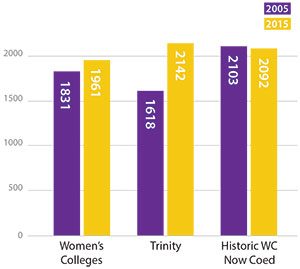
Women’s Colleges Enrollment
Changes 2005 to 2015
In general, despite the Sweet Briar story, the 38 remaining women’s colleges have actually grown slightly in the decade 2005-2015 (see chart). By comparison, the group of approximately 102 coeducational colleges and universities that once were women’s colleges had a small enrollment decline in the same period. Trinity’s enrollment in that same decade grew more robustly.
In more recent years, Trinity’s overall enrollment has experienced a modest decline to about 2,000 students, but the enrollment in the College of Arts and Sciences has remained strong at about 950-1,000 students in any given semester. Enrollment challenges for our professional schools arise largely from the instability of the federal workforce in Washington at a time when government cutbacks roil various agencies; additionally, changes in teacher licensure providers from universities to independent agencies have also had a negative impact on our School of Education enrollment. Nevertheless, our programs in Nursing and Occupational Therapy are growing, and we believe the future of health professions programs at Trinity is quite strong.
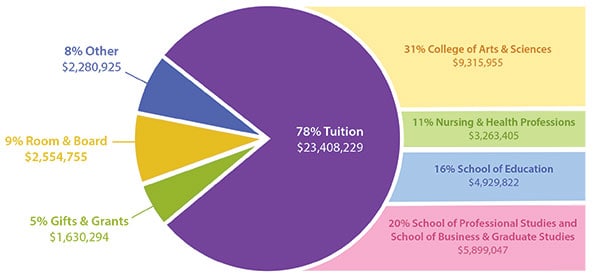
Trinity Revenues 2017
Trinity is financially sound and reasonably stable in a higher education environment that seems quite volatile. The metropolitan Washington region is growing and the demand for a well-educated workforce is ever present. Trinity has a very strong reputation among the schools, employers and communities throughout the Washington region. We enjoy a broad network of partners supporting our clinical education requirements in Nursing, Occupational Therapy, Counseling and Teacher Education, and locations for internships for all of our programs.
Trinity’s budget in Fiscal 2017 was just about $30 million. As the chart above reveals, nearly 90% of our revenues are generated by student tuition, room and board. 5% of the revenues come from gifts, grants and contracts, and the balance of the revenues come from other sources such as conferences.
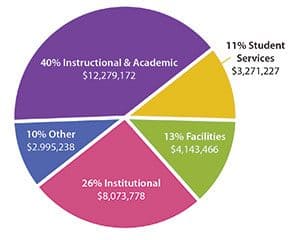
Trinity Expenses 2017
On the expense side, instructional and academic support as well as student services account for about 51% of all expenses, with general institutional expenses taking about 26%. “General institutional” is a category that includes such items as technology services, the business office, security, insurance costs, and other costs related to running the university. As the graphic shows, we spend 13% of the budget on facilities, but we could spend much more if we had the resources.
The operating budget of $30 million does not include the more than $11 million Trinity awards in grants and scholarships to students. Trinity students are fortunate to have generous scholarships provided by remarkable donors. Some examples of the top scholarship programs include:
Conway Scholars in Nursing: Thanks to the generosity of Joanne and William Conway through their Bedford Falls Foundation, 80 Nursing students have generous scholarships to help support their studies at Trinity.
Dreamer Scholars: Thanks to generous benefactors through TheDream.Us and other sources, 100 Trinity students have Dreamer scholarships. Dreamers are undocumented students with DACA status, and are ineligible for federal financial aid, so the private scholarships help to close the gap in funding their college education.
Luce Scholars: As a result of the bequest of Clare Boothe Luce in 1988, Trinity receives support for faculty Luce Professors and also student Luce Scholars.
Shannon Scholars: With the generous support of The Shannon Foundation and Mary Shannon ’60, eight Trinity students receive support to fund their Trinity education.
While we are so fortunate to have many generous scholarship donors, the fact remains that many of our students need much more support. About $9 million of the $11 million we provide in grants is what is known as “unfunded discount,” grants that reduce tuition without cash support. This is not unusual in higher education today, and Trinity’s “discount rate” of about 42% is actually better than many colleges serving wealthier populations.
Trinity 125: The Campaign for Trinity Students
Raising more money for scholarship support for our worthy students is a top priority for Trinity in our next campaign. The “unfunded” discount of $9 million is essential to help our students stay in school, but it diminishes the resources we have available for faculty support and facilities development. If we could fund even half of the discount with real scholarships, our budget would have a great deal more flexibility to address large needs like improving facilities and growing faculty salaries to stay competitive.
Trinty 125 is the campaign that will mark the celebration of Trinity’s 125th Anniversary in the Year 2022. While still in the early planning stages, we know that we must develop significant new resources for these great needs:
Scholarships: Deep scholarship resources help Trinity to recruit and retain outstanding students. Tuition in 2018-2019 will be $23,740, and with room, board and other expenses, the “total cost of attendance” is just about $35,000. While this is about half of what other private universities in the District of Columbia charge these days, a large number of Trinity students are women who experience financial hardship, so even our relatively modest tuition is a struggle. The median family income for students in the College of Arts and Sciences is just $25,000, and the average “expected family contribution” to support tuition is just $2,800 this year based on federal financial aid records. While federal financial aid like Pell Grants and student loans can close some of that gap, the largest source of support comes from Trinity’s own grants and scholarships. Enlarging these resources must be our top priority in the Trinity 125 campaign.
Facilities: The glorious Payden Academic Center has quickly become the most popular gathering spot on campus – the building is both beautiful and comfortable. Our challenge now is to bring our venerable historic buildings up to the very high standard set by the Payden Center. While we have many needs, Alumnae Hall is likely to be the next building project for several important reasons: the building houses our dining hall and kitchen, which are essential to support campus needs and student life. Without air conditioning, however, the building can be uncomfortable in the hot months. Alumnae Hall also has residence halls that are in great need of modernization, along with plumbing, electrical and HVAC throughout. And that old cage elevator must go! We are currently evaluating the likely costs of a renovation project.
Innovation and Excellence: With some major grants in the last few years – HHMI, Mellon, and a large Carnegie Corporation Award – Trinity’s faculty and students have reaped many benefits that have enlarged the quality and reputation of academics at Trinity. The HHMI and Mellon grant projects appear earlier in this report. Meanwhile, the $500,000 from the Carnegie Corporation has funded a wide range of academic projects that are truly transformative, from creating a new study abroad program, to developing a university-wide writing program, to strengthening academic advising, to supporting faculty who are engaging in innovative work for programs in all academic units. Realizing the considerable benefits of this kind of support for faculty innovation, the Trinity 125 campaign will seek to enlarge the pool of resources available to support ongoing creative development of Trinity’s academic and co-curricular programs.
120 years ago, a bold group of religious women had a grand vision for a great college to educate women who, in that day, had few options for advanced study. Excluded by their gender not only from college but from many other rights and privileges of American life (including the right to vote, to own property, to work in many professions), women at the end of the 19th Century were growing increasingly restless, and some were so bold as to spark revolutions. The Sisters of Notre Dame de Namur carried that spark to a remote plot of land on the far outskirts of the nation’s capital, and despite opposition from within the Church and the ongoing challenge of poverty, they managed to establish Trinity College, using that spark to illuminate the minds and hearts of women across generations.
Trinity students today – still 95% women, and some really great men in our graduate and professional programs – continue to receive that spark with pride and ambition. Our students carry that symbolic “torch of learning” high every day, striving to learn despite many difficulties, learning to be resilient amid setbacks and courageous in moving ahead with the knowledge gained in each experiment, research project, book read and problem solved.
Trinity persists and thrives today thanks to the very hard work of a great faculty, devoted staff, loyal and generous alumnae and alumni, and many great institutional friends. The Sisters of Notre Dame de Namur today continuously express their affirmation of all that Trinity has become in this first part of the 21st Century. Together, we look to the next part of this journey with optimism, gratitude, and confidence that the strength, wisdom and love of the Trinity will be with us each day.
President Patricia McGuire